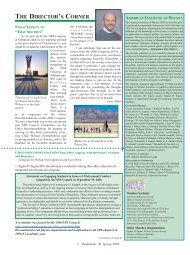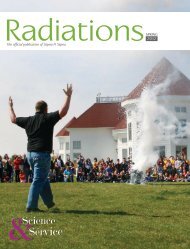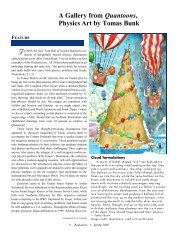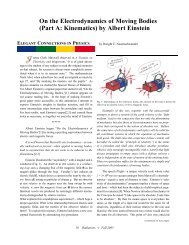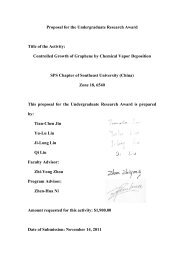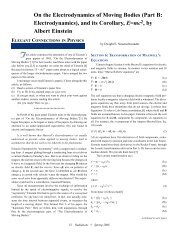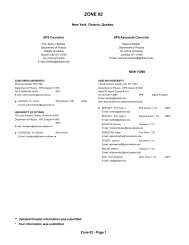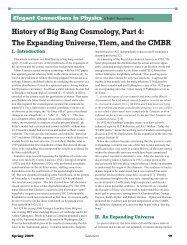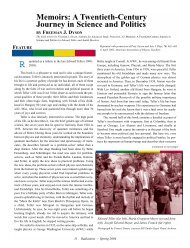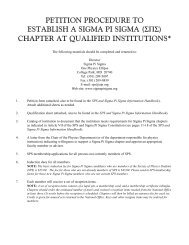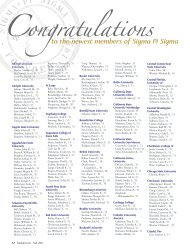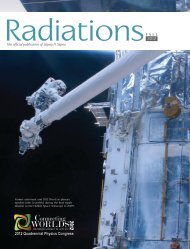Download a PDF of the entire issue - Sigma Pi Sigma
Download a PDF of the entire issue - Sigma Pi Sigma
Download a PDF of the entire issue - Sigma Pi Sigma
You also want an ePaper? Increase the reach of your titles
YUMPU automatically turns print PDFs into web optimized ePapers that Google loves.
Elegant Connections in Physics<br />
man astronaut in a 15-minute suborbital<br />
flight aboard his Mercury capsule<br />
named Freedom 7. Three weeks later, on<br />
May 25, 1961, in view <strong>of</strong> recent events<br />
on <strong>the</strong> ground and in space, President<br />
Kennedy addressed a joint session <strong>of</strong> <strong>the</strong><br />
United States Congress in a speech on<br />
“Urgent National Needs.”<br />
Kennedy began by describing <strong>the</strong><br />
Cold War as “a battle for minds and<br />
souls as well as lives and territory.” In a<br />
paragraph distributed to <strong>the</strong> listening<br />
Congress but not read from <strong>the</strong> podium,<br />
Kennedy described how <strong>the</strong> “adversaries<br />
<strong>of</strong> freedom” were attempting to “make<br />
<strong>the</strong> most <strong>of</strong> <strong>the</strong>ir scientific successes,<br />
<strong>the</strong>ir economic progress, and <strong>the</strong>ir pose<br />
as a foe <strong>of</strong> colonialism and friend <strong>of</strong> popular<br />
revolution.” The President’s speech<br />
<strong>of</strong>fered nine proposals, which he said<br />
“arise from <strong>the</strong> host <strong>of</strong> special opportunities<br />
and dangers which have become<br />
increasingly clear in recent months.”<br />
The bulk <strong>of</strong> Kennedy’s speech<br />
articulated initiatives for “economic and<br />
social progress” at home and abroad;<br />
partnerships for defense with NATO<br />
and o<strong>the</strong>r allies; reinforcements <strong>of</strong><br />
military and intelligence shields; civil<br />
defense improvements; and disarmament.<br />
Kennedy’s final proposal was<br />
unprecedented:<br />
“Finally, if we are to win <strong>the</strong> battle<br />
that is now going on around <strong>the</strong> world<br />
between freedom and tyranny, <strong>the</strong><br />
dramatic achievements in space which<br />
occurred in recent weeks should have<br />
made clear to us all, as did <strong>the</strong> Sputnik<br />
in 1957, <strong>the</strong> impact <strong>of</strong> this adventure on<br />
<strong>the</strong> minds <strong>of</strong> men everywhere, who are<br />
attempting to make a determination <strong>of</strong><br />
which road <strong>the</strong>y should take. Since early<br />
in my term, our efforts in space have<br />
been under review. . . . Now it is time<br />
to take longer strides—time for a great<br />
new American enterprise—time for this<br />
nation to take a clearly leading role in<br />
space achievement, which in many ways<br />
may hold <strong>the</strong> key to our future on Earth.<br />
“Recognizing <strong>the</strong> head start obtained<br />
by <strong>the</strong> Soviets with <strong>the</strong>ir large rocket<br />
engines, . . . we never<strong>the</strong>less are required<br />
to make new efforts on our own. . . . But<br />
this is not merely a race. Space is open<br />
to us now; and our eagerness to share its<br />
meaning is not governed by <strong>the</strong> efforts<br />
<strong>of</strong> o<strong>the</strong>rs. . . . I <strong>the</strong>refore ask <strong>the</strong> Congress<br />
. . . to provide <strong>the</strong> funds which are<br />
needed to meet <strong>the</strong> following national<br />
goals:<br />
“I believe that this nation should<br />
commit itself to achieving <strong>the</strong> goal,<br />
before this decade is out, <strong>of</strong> landing a<br />
man on <strong>the</strong> moon and returning him<br />
safely to Earth. No single space project<br />
<strong>of</strong> this period will be more impressive<br />
to mankind, or more important for <strong>the</strong><br />
long-range exploration <strong>of</strong> space; and<br />
none will be so difficult or expensive<br />
to accomplish. . . . But in a very real<br />
sense, it will not be one man going to<br />
<strong>the</strong> moon—if we make this judgment<br />
affirmatively, it will be an <strong>entire</strong> nation.<br />
For all <strong>of</strong> us must work to put him<br />
<strong>the</strong>re. . . .”<br />
With congressional approval soon following,<br />
NASA instantly had a long-term<br />
mission that was focused, urgent, and<br />
important. The 1960s was an exciting<br />
decade for looking up. . . .<br />
Television sets were frequently rolled<br />
into classrooms. The images still persist <strong>of</strong><br />
<strong>the</strong> smiling astronauts striding confidently<br />
toward <strong>the</strong> rocket; <strong>the</strong> roar <strong>of</strong> <strong>the</strong> launch;<br />
<strong>the</strong> spectacular photos from orbit showing<br />
<strong>the</strong> black capsule with its white-and-gold<br />
service module floating above <strong>the</strong> beautiful<br />
white-and-blue Earth below; <strong>the</strong> space<br />
walks; <strong>the</strong> gold wash on <strong>the</strong> faceplate <strong>of</strong><br />
<strong>the</strong> astronaut’s helmet; <strong>the</strong> fiery re-entries;<br />
<strong>the</strong> capsule suspended from red and white<br />
parachutes splashing down; <strong>the</strong> Navy frogmen<br />
jumping from <strong>the</strong> hovering helicopter<br />
to <strong>the</strong> bobbing capsule; <strong>the</strong> joyous reunions<br />
on <strong>the</strong> recovery ship as <strong>the</strong> astronauts<br />
emerge still smiling and waving. . . . These<br />
images became part <strong>of</strong> our lives, and we<br />
RIGHT<br />
Edward White during <strong>the</strong> first “space walk,”<br />
Gemini 4. June 3, 1965. NASA photo.<br />
BELOW<br />
John Glenn aboard Friendship 7, February 20, 1962.<br />
NASA photo.<br />
20 Radiations Fall 2011



